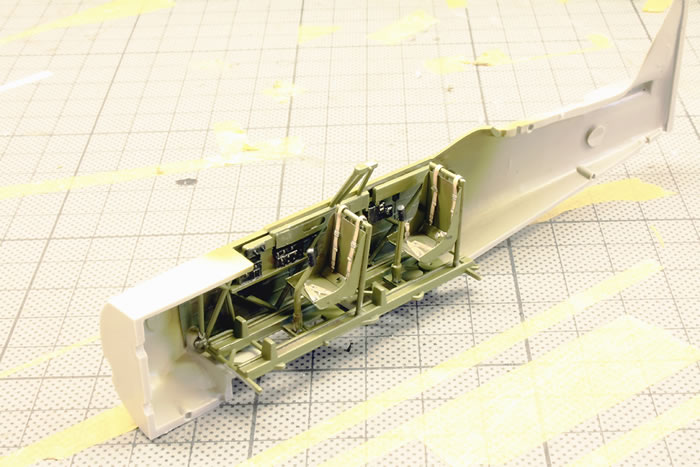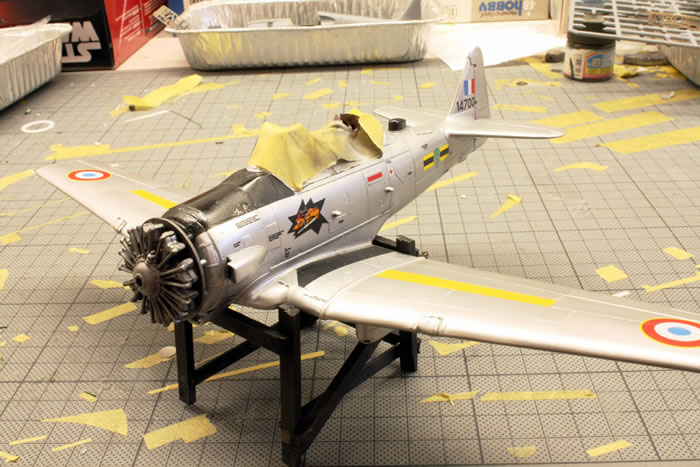Italeri 1/48 scale
T-6G Texan
by Roland Sachsenhofer
|
North American T-6G Texan |

It is not surprising that a wide range of variants and versions can be found in an aircraft type which, with more than 15,500 examples, is one of the most built designs in history. The high production figures ensure that the T6 Texan is still in regular service with numerous surviving veterans at flying days and sightseeing flights, and thus enjoys a high level of recognition and popularity.
The North American AT-6 was designed as a trainer and was also used as such in numerous air forces. Fully aerobatic and well powered, the AT-6 Texan and Harvard helped thousands of Allied pilots to their first encounter with advanced forms of military aviation. The two largest users, the USAAF/USAF and the RAF, also found use as light ground combat aircraft for the versatile model.
The T-6 was able to deploy a wide range of weapons, which kept the aircraft interesting for military users even after the end of World War II. In the increasingly intense conflicts that flared up after 1945 in the course of the decolonization of Africa, Far East Asia and Latin America, there was a great need for aircraft material suitable for COIN warfare.
Thus the British, but above all France, Portugal or Belgium, used the readily available and flexibly equipped T-6s for "counterinsurgency", as these missions were called in the old colonial manner. The weapon load of the T-6 in this role was quite impressive.
The French, for example, equipped their T-6 with a total of four 7.5mm machine guns in two nacelles, as well as mountings for 18 unguided 36mm rockets, bombs or napalm containers each.T-6 Texans were called "Tomcat" by the French, by the way; the danger of confusion with an more modern F-14 remains, thank God, small.
Even before the Algerian war, which lasted from 1954 to 1962, would lead France to the brink of a national crisis at the end of the 1950s, the T-6 "Tomcats" were already used on a large scale in the fight against ground targets. Soon after 1960, however, the type was to be replaced more and more by the much more powerful T-28 Trojan, but remained a backbone in the arsenal of the French Air Force fighting in Algeria.
My model shows one of these T6G Tomcat/ Texan, as it was used by the EALA 3/1 in Algeria in 1961.
The markings of the "Air Pluto", as the machine was called thanks to its "nose-art", are from the Italeri re-edition of the kit by Occidental, first published in 1998. The forms show solid fitting accuracy. With the somewhat rough treatment of details in the cockpit or in the landing gear area the quite successful design of surface structures on fuselage and wings reconciles.

The cockpit, which is quite well visible, could be " renovated" with a suitable Eduard set, whereby also the landing gear with scratched part spring strut scissors as well as the engine with a complete ignition wiring profited.
Brake lines made of copper wire as well as an exhaust pipe turned from tin foil, which replaced the unusable kit part, completed the refinement measures.
Reasonable effort was also put into the implementation of an already somewhat weathered natural metal surface: for this purpose different Alclad metal tones were applied in several layers, some of which were separated by dabbed-on masking fluid. After rubbing off this separating layer, the metal underneath reappeared, this in the right light gives a nicely weathered overall impression.

The decals of the kit are well usable, even if they are printed on a somewhat thick and rather matt carrier film. A thick layer of glossy clear varnish as a base and afterwards as a sealant for the decals ensures that the resulting surface appears flush and prevents the decals from "silvering".

Sadly, the multi-part cockpit canopy cannot be shown in open condition; the individual elements are correctly sized, but cannot be slid into each other.
In conclusion I may say that I am very pleased with this model with its solid parts and the squiggly approach. The cockpit and landing gear area are an invitation to detailing, which, measured against today's expectations and possibilities, cannot be refused. The rest is pure modelling pleasure that blends with the gripping story that the little-known real-life original has to tell. What more could you want?
If you are interested in the building process, please have a look here on Scalemates:
https://www.scalemates.com/profiles/mate.php?id=10148&p=albums&album=58791
As ever, remarks will be appreciated: ro.sachsenhofer@gmx.at
Model, Images and Text Copyright ©
2020 by Roland Sachsenhofer
Page Created 12 August, 2020
Last Updated
13 August, 2020
Back to HyperScale Main Page

|
Home
| What's New | Features | Gallery | Reviews | Reference | Resource Guides | Forum |